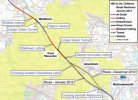Hi, non rail industry person here. Interested in what has gone wrong/right with HS2 so far.
Just wondering if anyone here could provide some insight as to if the Chiltern Tunnel and Colne Valley Viaducts were necessary from an engineering standpoint, or if they were primarily built to protect the ‘AONB’.
If we had not needed to worry about any NIMBYs, and had reduced the design speed from 400kph to 300kph, would there have been significantly cheaper routes through the region?
Many thanks
Just wondering if anyone here could provide some insight as to if the Chiltern Tunnel and Colne Valley Viaducts were necessary from an engineering standpoint, or if they were primarily built to protect the ‘AONB’.
If we had not needed to worry about any NIMBYs, and had reduced the design speed from 400kph to 300kph, would there have been significantly cheaper routes through the region?
Many thanks


